|
|
|
 |
Starship Class |  |
|
Here are some other classes of Starships. Classes, |
|
|
NX Class: 2151 - 2210 Representing the new Starfleet initiative of a United Earth, the NX Class was the boldest starship project to date. The prototype vessel called Enterprise was launched under the Command of Captain Archer, and amongst the crew was a single Vulcan representative, whose role was chiefly an observer, but was there also to help midwife the Humans into a new era of interstellar exploration. The Enterprise's first mission involved the potentially hazardous first contact with the Klingons, and would have significant ramifications for many years to come. The actual ship itself was commissioned under the new Starfleet charter, and would be the first of a new warp 5 capable fleet, and carried the first of the unique NX registration systems, which gave rise to NCC later on. |
 |
| Miranda Class: 2261 - Still in Service Light Cruiser type starship, of which later variant, Soyuz Class (an experimental Destroyer) was based. The Miranda Class was introduced initially as a deep range explorer vessel, eventually specialising in only scientific research by the mid 24th century. It was first introduced nearly twenty years after Constitution Class and the two were intended to bear the torch as Starfleet's foremost 'exploring' vessels. After many years in service though, and after being outclassed by succeeding classes, a lot of Miranda Class ships were decommissioned, though some were refitted, as is common with all starships after a certain 'mileage'. But In the early 24th century, other variants of the original prototype were commissioned, encompassing slightly different designs externally, but a lot more advanced as far as internal systems go, for instance IOC's (Isolinear Optical Chips) were (possibly) employed on these newer variants. |
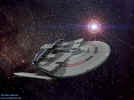 |
|
Danube Class: 2368 - Still in Service 374 of these very successful ships have so far been built Fleet-wide. Usually carried by various space stations and Starbases, and some Starships, these vessels, nicknamed 'Runabouts' are primarily deployed in similar capacities as executive shuttles, though Danube's weapons, shields and propulsion systems are far in advance of regular shuttles. Normally used for short range recon, and transport, though of limited numbers, they're very handy for fast and convenient transport over interplanetary and limited interstellar distances. Quick, sleek, and highly manoeuvrable, they're an excellent addition to the fleet. |
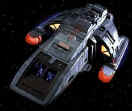 |
|
Oberth Class: 2189 - Still in Service Small, versatile, fairly low maintenance long-range science vessels. Sporadic construction of this class lasted until 2348, and 43 still remain in service, most of which were originally Starfleet registered, others being reserved for private/scientific charter. This is common amongst the scientific vessels, particularly the smaller ones. The remainder are reserved for special ops, and chartered missions. In a way, the Oberth Class was a common, production line model, made in bulk, and many races and groups were permitted to use this design, though only under the Federation 'banner'. One could presume this arrangement was common with other minor vessels, such as Sydney, Surak, and Antares Classes, amongst others. Whilst being a fairly versatile design, featuring full saucer separation capability, Starfleet have often used these as guinea pigs for prototype technologies and experiments. The general success of this small starship is demonstrated by how incredibly long it has been in service, albeit as several different variants since the initial 22nd century prototype. In the 24th century the failed, and controversial USS Pegasus (which remains classified), was an Oberth Class vessel, and is highlighted below. As the Oberths were primarily science vessels, many were named as tributes, or after significant scientific persons, achievements, or moments in history. |
 |
|
Sabre Class: 2353 - Still in Service Type of Light Cruiser, similar in many ways to an advanced, latter day Miranda Class, but on a smaller scale. Many of the advanced systems for a proposed refit are experimental, and are pending further research and tests. When such engineering issues are ironed out a great deal more in this class are planned for construction. |
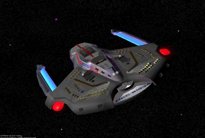 |
|
Intrepid Class: 2367 - Still in Service First constructed at Earth Station McKinley (an ancillary construction yard), the prototype Intrepid 4 was first designated as a long range exploration vehicle. It was not the largest or indeed most powerful of ships but was extremely resilient, and with retractable nacelles and enhanced warp propulsion systems was extremely fast. When most in this class were first launched they carried 175 Photon Torpedoes, only months later were they recalled for Quantum Torpedo upgrades (except the missing Voyager ;). The prototype was also a Guinea Pig for a speculative addition to IOCs: a type of bio-neural organic gel pack unit, designed to relay and process computer information at new high speeds. Has so far proven a fair success. * Initially designated 'Planform SV-65', the Advanced Starship Design Bureau began the starship project which become the Intrepid Class in 2361. The eventual design was finalised in 2367, and the first ship to be completed ended up being called Voyager, three months ahead of the official prototype Intrepid 4. |
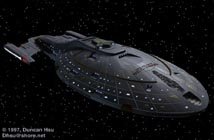 |
|
Nebula Class: 2351 - Still in Service This enormously powerful and formidable starship class is looked upon by most as either beautiful, or ugly, but its effectiveness can't really be questioned. Planned alongside the Galaxy prototype at Utopia Planitia, it was first commissioned a few years before her larger cousin. The Nebula Class underwent continued construction for a further decade and a half amassing a large 83 ships, making her a fleet spearhead in many field deployment areas. This class saw a slight design alteration at one point, for the first vessels of this class (the older ones, built in the 2350's) had a disk shaped sensor platform, as opposed to a triangular shaped tactical and sensor platform later on. In a way the Nebulas resemble Galaxy Class, sporting a similar design, though having this raised tactical and sensor platform aft, and heavily sunken nacelles. But on a slightly smaller scale to Galaxy Class, the Nebulas were a match in almost all other departments. |
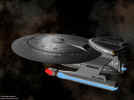 |